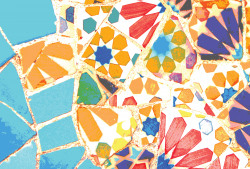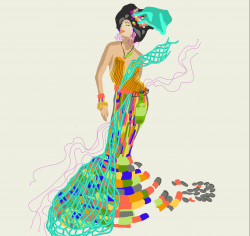Fully expecting a ceramic exhibition that showcased the traditional precision and symmetry of Japanese art—think delicate cherry blossoms on a silk screen—I could initially only find two words to justify the anomaly I saw at the Freer Museum’s Oribe Ware exhibit: poor craftsmanship.
Overlooking the wear from being a few centuries old, the collection of eleven ceramics, all created during the 17th century in Miro, a small province of Japan, were simply inconsistent. The glazes were unevenly applied on the stoneware, bowls were hardly circular in shape, and composition on the utensils’ stone surfaces was fragmented and incohesive. In the end, I found that these characteristics are what makes the Oribe Ware collection a perplexing and intriguing feature in the Japanese ceramic art history timeline.
Oribe Ware’s departure from the traditional monochromatic composition was largely due to influence of Furuta Oribe, a 17th century warrior and tea ceremony master who was highly respected in Japan. As you look through the pieces, all organized chronologically by creation dates, from 1607 to 1789, it is clear that this short movement introduced bright glazes, asymmetry, and geometric pattern to Japanese art in two cycles: one towards the beginning of the 15th century and another towards the end of it. No longer would ceramics be crafted solely for utility purposes. “Teabowl,” for example, has deliberately uneven edges on its oval rim, giving the drinker a heightened sense of awareness of the cup when choosing which of its many different sides to drink out of, as explained by the curators in its placard description.
The centerpiece of the exhibit, an early 1600s oversized serving dish, is peppered with geometric and organic patterns and interspersed with emerald and blue glazes that bleed into and around the carved geometric designs, overall contributing to a piece that contrasts natural colors with unnatural patterns, such as its repeating hexagon design. There is a sense of vibrancy, frivolousness, and energy that accompanies this revolutionary art style.
Poor craftsmanship? Perhaps true when considering that these 17th century potters were experimenting with the newly invented Motoyashiki multi-chamber climbing kiln to fire their works. However, the bright glaze blots that unevenly coat the handle of the Ewer, a type of teapot, while framing a natural painted depiction of flowers on a branch, characterizes 17th century Japanese artists as risky and flexible, combining old traditional painting style with a new, free-form one. While a short lived fad, the Oribe Ware movement made it acceptable to introduce color into ceramics and expand its aesthetic features beyond simply enhancing the utility in a teapot, a plate, or a cup. It introduced the concept of establishing mood.
The emphasis on mood and emotion in these pieces comes from the varied concentration of colors, ranging from a light application to a heavy multi-layer coating on various portions of pieces. Another small serving dish designed by Kagenori, a Japanese maker, reveals his deliberate choice to strike a sense of imbalance in his lopsided and hesitantly crafted ceramic ware. The darkly glazed portions resemble a deep sea and imply a feeling of distress, while lighter glazes evoke a more ephemeral and light-hearted aura.
Exploring new art forms and techniques does not guarantee that the products are perfect. For Oribe Ware, many growing artists partook in its divergent and risky style, evident in the jagged square edges on plates and uneven surfaces of pots from the era. But I’ll have to chastise myself for a second, because poor craftsmanship is indeed a cheap and shabby way to discount what came to be a radical and influential movement that modernized the future of Japanese ceramic art.
Maybe to you, the collection is just a grotesque and mismatched ancient dinnerware set, and Furuta Oribe was simply horrible at using a potter’s wheel. Regardless, this small, yet powerful, exhibit will make you wonder if you really understand all that Japanese art has to offer.
Freer Gallery of Art
1050 Independence Ave S.W.
Mon. – Sun. 10 a.m. – 5:30 p.m
si.edu




